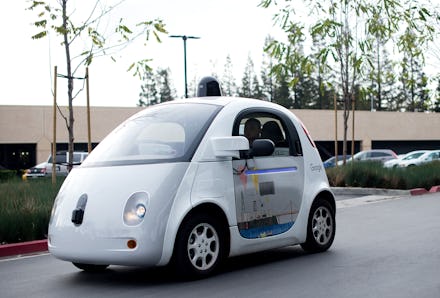Google Just Got the Go-Ahead It Needed to Make Self-Driving Cars a Reality

Google has just gotten the U.S. government to acknowledge that its autonomous car system is a driver.
In a letter to Google, the National Highway Traffic Safety Administration outlines when and how the company's self-driving system could be considered a driver. In an effort to legally replace human drivers with artificial ones, Google's Self-Driving Car Project team has sought the recommendations of the NHTSA. In response, the agency granted Google quite an array of circumstances in which self-driving cars would be acceptable.
"As a foundational starting point for the interpretations below, NHTSA will interpret 'driver' in the context of Google's described motor vehicle design as referring to the SDS, and not to any of the vehicle occupants," the agency writes. "We agree with Google its SDV will not have a 'driver' in the traditional sense that vehicles have had drivers during the last more than 100 years."
The letter goes on to say that given Google's description of its automated cars, "even if it were possible for a human occupant to determine the location of Google's steering control system, and sit immediately behind it, that human occupant would not be capable of actually driving the vehicle as described by Google. If no human occupant of the vehicle can actually drive the vehicle, it is more reasonable to identify the 'driver' as whatever (as opposed to whoever) is doing the driving. In this instance, an item of motor vehicle equipment, the SDS, is actually driving the vehicle."
This interpretation could be big for car manufacturers working to build intelligent cars. However, while the recognition of a self-driving system as a driver is a milestone, it is far from the last word on self-driving cars.
As the agency notes, "In many instances, interpreting the term 'driver' in a manner that Google has requested does not necessarily change the requirements of the regulation or otherwise fully resolve the issue Google seeks to address."
The NHTSA has limited abilities. Though it can help Google meet the requirements of certain existing traffic and transportation laws by identifying its SDS as a driver, it can't override the law. In particular, laws that require cars to have certain features, like steering wheels and gearshifts, will have to be augmented to include self-driving cars that may not have these accoutrement.
Google and other car companies investing in autonomous vehicles have expressed dismay at some of the early legislation aimed at smart cars and the slow-moving nature of bureaucracy in adapting laws to this new technology. In getting the NHTSA to accept the SDS as a driver, the company is likely seeking alternative ways to get its technology approved in the event that local and national governments fail to pass new regulations quickly. But as the NHTSA says, this isn't a full solution. Eventually Google will need to seek exemption from certain laws.
This is just one area of the law Google has to circumnavigate in order to get its vehicles on the road. A recent patent indicates the company is also interested in putting autonomous delivery vehicles on the road — a territory not currently defined by the legal system.
In the meantime, the NHTSA is exploring a re-examination of current legislation to see if it's relevant to the shift that's happening from manual driving to automated. The review could result in certain laws and provisions being axed or altered in order to usher in this new wave of car technology. However, such changes are likely to take months, even years.
h/t Reuters